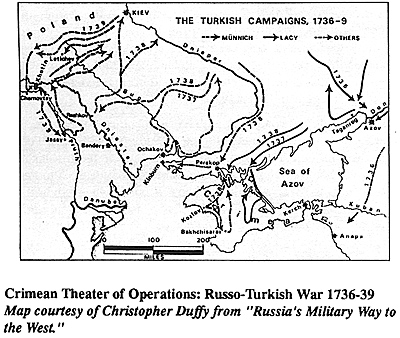Russia had its eye on the Black Sea and with the threat from Sweden settled and with Poland secure, the time seemed ripe for Russia to strike at the Ottomans. Empress Anne of Russia worked out an agreement with Austria, which wanted Bosnia and Herzegovina. Russia cited raids by the Crimean Tartars as grounds for an ultimatum issued to the Sultan. War was declared on May 2, 1736.
The Ottoman army had not been mobilized, so the Sultan relied on the Tartar forces to delay the Russians. The Russian army commanded by Marshall Munnich rolled over the Tartars, seizing the entire Crimean Peninsula. Unfortunately for the Russians, they completely out-ran their supply lines and foraging for food in this area was impossible. Disease and starvation set in, forcing the Russians to abandon the entire Crimea. In mid-1737, Russia tried to conquor Moldavia, but the Ottomans held the line at the Dneister River.
The Austrians entered the war in 1737. Their main thrust was along the Vardar River (which flows from Greece to Serbia). The Austrians received assistance from all of the local people, Serbs and Montenegrins. They were able to capture Sarajevo, Nis, Wallachia and parts of Moldavia. This was a rather large area to hold and the Austrians distributed their forces throughout the region in small garrisons.
The Ottomans decided to deal with the Austrians first. Led by the Bombardier Corps, the Ottomans were successful in their counterattacks. The Austrians were defeated at Banjaluka and Bucharest during the fall of 1737. In 1738, the Ottomans launched several campaigns that resulted in the recapture of Belgrade, Semendria and Irsova. This placed the Ottomans in a defensive position along the Danube River. Austria signed the Treaty of Belgrade on September 18, 1739, effectively losing all territorial gains won in the Treaty of Passarovitz in 1718.
This treaty favored the Ottomans in several ways. The negotiator, the Marquis de Villeneuve, pressured Austria since he knew that Austria was concerned about the health of Emperor Charles. The treaty restored the old boundaries of the Sava and Danube rivers. With the treaty signed, it freed up 200,000 troops that were flghting on the Austrian front, for service against the Russians.
Early in 1739 the Russians launched an invasion into Moldavia. The city of Jassy was captured and the Russians were preparing to invade Wallachia when they received the news of the Austrian capitulation at Belgrade. The Russians were experiencing their usual supply problems and this news compelled them to agree to a peace treaty in October. Russia restored Azov, the Crimea and all of Moldavia to the Ottomans, while the Porte agreed to accept responsibility for the behavior of the Tartars and to allow the Russians trade and religious travel rights.
Map of Crimean Theater of Operations
Russo-Turkish War 1736-39. Map courtesy of Christopher Duffy from Russia's Military Way to the West.

More Ottoman Empire in the 18th Century
- War With Persia 1723-1736
War With Austria and Russia 1736-1739
Resumption of the war with Persia 1742-1746
Russian War of 1768-1774
Back to Seven Years War Asso. Journal Vol. VII No. 2 Table of Contents
Back to Seven Years War Asso. Journal List of Issues
Back to Master Magazine List
© Copyright 1994 by James E. Purky
This article appears in MagWeb (Magazine Web) on the Internet World Wide Web.
Other military history articles and gaming articles are available at http://www.magweb.com